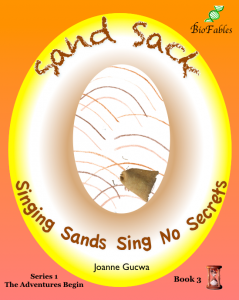 What’s cooler than a geodesic tent? Igloos! (They have the same basic overall shape). Also cool: learning that the straight lines of their family tent’s triangles and an igloo’s square-ish blocks of snow are arranged to make surfaces that are rounded. What’s hot? Climbing sand dunes in summer. Mallory’s seven-year-old twin sister, Melody, enjoys the heat. Mallory? Not so much.
What’s cooler than a geodesic tent? Igloos! (They have the same basic overall shape). Also cool: learning that the straight lines of their family tent’s triangles and an igloo’s square-ish blocks of snow are arranged to make surfaces that are rounded. What’s hot? Climbing sand dunes in summer. Mallory’s seven-year-old twin sister, Melody, enjoys the heat. Mallory? Not so much.
Mallory and his Dad head back down the dune while his Mom and sister  continue their upward trek. In the shade of a small bush, Mallory discovers more than cooler sand as he settles into a little trench that his dog Rufus helped to dig. When Mallory and his father visit the local Indiana Dunes police station to turn in their find, they learn why some dunes are called “living.”
continue their upward trek. In the shade of a small bush, Mallory discovers more than cooler sand as he settles into a little trench that his dog Rufus helped to dig. When Mallory and his father visit the local Indiana Dunes police station to turn in their find, they learn why some dunes are called “living.”
BioFables children’s books focus on illuminating Sciences (STEM: Science, Technology, Engineering, Math) principles through fun stories. Parents, you know from experience that learning the subject matter that we call Sciences is a good first step. Understanding Humanities subjects helps us know how best to apply Sciences principles to the practical needs of the external world. And understanding one’s internal Values/Behaviors helps us to make things happen.
Every BioFables book weaves lessons derived from these interconnected (and often hidden) core disciplines into realistic stories that children relate to. Parents, you can use the free resources of this site to uncover those nearly-invisible lessons. They will help you prepare your children for happy, productive, rewarding and well-balanced lives.
If you’re read to purchase Sand Sack, please click on the Buy Sand Sack icon to go directly to Barnes and Nobles’ Sand Sack page. (Your purchase of Whoosh helps support our ongoing efforts to continue expanding the wealth of this site’s free resources for homeschooling and for all parents who are dedicated to the intellectual growth of their children.
If you’d like to learn more about using the considerable Sand Sack resources at this site, please read on.
Sand Sack Resources
The ten chapters in Sand Sack contain nearly a hundred practical mini-lessons and pop-up lessons woven throughout Whoosh. We call these practical lessons Knowledge Nuggets. These Knowledge Nuggets contain specific information that readers can apply to their everyday lives. They may be in the form of a mini-lesson, with simple explanations of a specific concept, or as a quick, unplanned pop-up lesson.
Four sets of tables and lists in the Sand Sack Knowledge Gateways page help you to place a given Knowledge Nugget within the greater realm of learning.
-
- Chapter-by-Chapter: Sciences, Humanities, Values/Behaviors
- Entire Sand Sack: Sciences topics
- Entire Sand Sack: Humanities topics
- Entire Sand Sack: Values/Behaviors topics
Please visit Site Tips for even more ways to mine the wealth of information available on this site.


